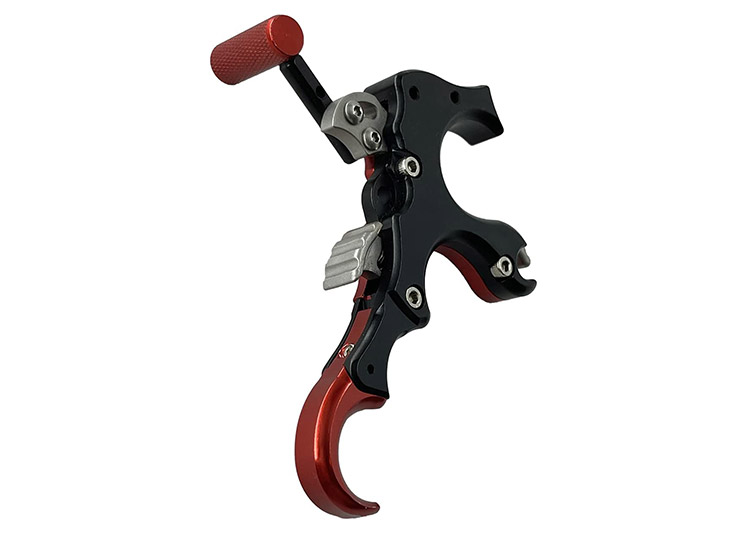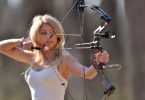Some may say bow releases are not really necessary for your compound bow. But sooner or later you’ll realize that you’ll need one for your comfort, confidence, and consistency.
But if you’re new to archery, it might be difficult for you to pick the right type of bow release from so many variations. Then learning how to use a bow release will be another challenge.
Here we showed you how to use different types of bow releases so you can take your skill to the next level in no time.
How to Use a Mechanical Bow Release in Archery?

When it comes to the best bow release, the mechanical release comes first in mind as it ensures more accuracy than the other types. This aid uses triggers rather than the finger to achieve utmost precision and accuracy.
Step 1: Attach the arrow on the bow
At the very first step, you’ll need to attach the release with the bow. Locate the accurate place where the bow will stay when you shoot.
You’ll find the arrow resting place at the middle of the bow, above the grip point.
Place the release on top of the seat if it is designed to place the bow from one side.
However, you’ll have to insert the release in case the resting place has an enclosed string to pass through the bow.
Step 2: Align the arrow with the bowstring
Now look for the arrow’s “nocking loop” at the end of the arrow near the ‘fin’ point. This is commonly known as the D-loop. Basically, it is the place from where you hook the releases to draw the bow.
Also, it holds the arrow’s nock and slides the string up and down during the shoot. But be sure there is no damaged or broken sign at the nocking point.
Step 3: Insert the nock into the bowstring
When you have aligned the nock at the center of the bowstring, press it inside the loop. You will hear a click sound, signaling that the release is firmly locked with the string.
In case there is no clicking sound, be sure the arrow isn’t locked securely. This may lead to misfiring in an unintended direction while releasing.
Step 4: Focus on the target
After completing the arrow setup, it is time to prepare for aiming and releasing the arrow to the target point.
Just grip the bow tightly with your hand, move it up, and aim your arrow at the target point. Make sure your arm is parallel to the ground where you are standing.
At this point, professional archers often close one eye to focus on the target with one sight. If you are at the beginner level, it is the most effective tactic to gain the skill of targeting.
Keep in mind that you are not focusing your aim on any person. Safety is always the first priority in archery.
Step 5: Put the caliper on the loop and set off the release
Take a caliper that can be opened on both sides simultaneously. Focus on where the arrow is making contact with the string. Then hook it up.
Now, push the bow away from you and pull the drawstring toward you. While doing so, you will see that the arrow stays perpendicular to the string.
Finally, release the arrow to your aim.
Instead of the caliper, you can also use the T-release and hook it similarly. When you turn your hand, you will see that there is an angle where the arrow hooks onto the string.
How to Use a Thumb Trigger Release?

Besides the index trigger, most bow hunters use a thumb trigger release in archery. Even with evaluating different ways to trigger the shot, it is getting much more popular in recent years for providing simplicity in the shooting.
That’s because the thumb has less sensitivity than the index finger, improving the aiming focus and ensuring the best shot.
- First, you have to set your thumb release in proper release positioning. Proper adjustment of the release aids is the first priority in archery. Make your hand release and loose now, grip the release firmly between your fingers but check if it is tight enough.
- Now it’s time to anchor your bow with the proper grip. You have to locate the proper place to anchor. You can have your jaw between the middle and index finger to get the exact anchor point. Most bow hunters use this technique to get a consistent and accurate anchor point.
- When done, make the proper adjustment to your bow. To do so, you’ll have to adjust your peep sight according to the bow and the target point.
- Don’t forget to position your thumb, as it is another major part of the thumb release. Take your finger in a relaxed position, as too much pressure will affect the shot.
- Now gently put the pressure on the trigger and start pulling it. Once you are ready, shoot it off.
How to Use a Hinge Release?

Hinge releases are also widely used release aids for taking archery shots. It is mainly known as a back-tension release or handheld release that is used to fire the shot by rotation.
Here the bow hunters rotate the releases with their thumb and index finger to make the shot.
Archers follow several more methods to rotate hinge releases. Here are some common ones:
#1- You’ll have to rotate the release from the index finger to the ring finger to draw the hinge release correctly.
#2– Then, make your hand and fingers release. As much as you put pressure, the release will fail to set up instead of rotating.
#3– Finally, transfer the weight to your index, middle, and ring fingers. Pull the elbow toward you and push pressure to set off the release.
How to Use a Wrist Strap Release?

The wrist strap release is mostly popular among the release aids in archery. This tool lets you curl your fingers over the trigger to give the shot.
You can easily set this release just like another standard index release. When you are pulling the d-loop, it will be going to fire without adding back tension.
First, put the wrist strap on your wrist and tighten it with the adjusted boa system if there are any.
Then, you have to ensure a good anchor with the wrist-strap release. It will be better to place your thumb on your jawbone.
When done, load the release on your D-loop, draw your bow, and squeeze the trigger with the proper anchor to deactivate the safety. Then keep pulling the string towards you until you get a perfect surprise.
If you are a beginner with the wrist strap, it will be highly better to use a shot trainer with the release aids.
Also, put your fingers behind the trigger when you draw your bow back to the anchor point. It will prevent the sudden shot.
How to Use Finger Tabs and Glove Releases?
Finger tabs are simply a safety tool that protects fingers while shooting. While the archer is pulling the string for drawing the bow, the finger tap will prevent the string from digging into the fingers, which may lead to the par.
- First, make sure you are using the right size of the tab that fits on your index finger.
- Now, grab the bowstring with your other hand and your index finger behind the arrow.
- When done, pull your elbow and set off the arrow.
Apart from this, different types of archery gloves are available to help hold the bow grip firmly. They are usually made of leather or nylon that protects your hands from being injured by the bowstring.
Now that you know how to use a bow release, you can confidently practice your hunting or shooting. Make sure that you find the right type of release because they’re there to help improve your performance, not hinder it.
FAQs
1. What releases do professional archers most often use?
Ans. Compound shooters mainly rely on the wrist strap and index-finger release while using a compound bow. It brings more accuracy in shooting. But handheld thumb release is their first choice when the term comes about less sensitivity to trigger feel.
2. Is it necessary to use a release aid?
Ans. Yes! Almost all compound archers use release aids for shooting. It makes releasing the bowstring faster and easier than your fingers do. Also, it improves the aiming focus, which ensures a pro shot.
3. Can I shoot a bow without a release?
Ans. Yes! Shooting a compound bow without using a mechanical release aid is possible. In that case, you will find a barebow division from where the archers release the string. Also, compound archers use a thumb ring to shoot the bow.









Leave a Comment